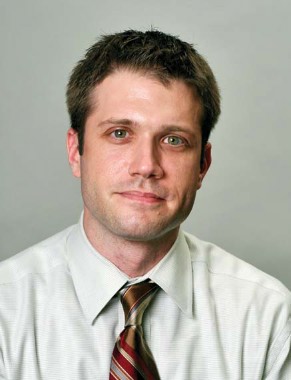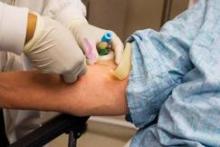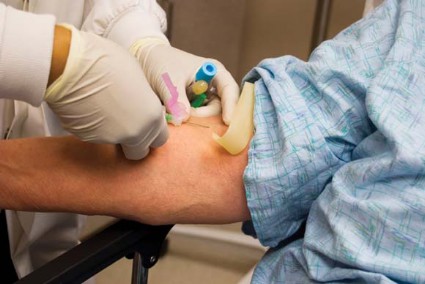User login
A simulation model that incorporated a one-time universal screening of U.S. adults for hepatitis C virus and made conservative assumptions as to the availability and efficacy of various therapies projected that the infection could become rare by 2026, according to a report published online Aug. 4 in the Annals of Internal Medicine.
Treatment for HCV has evolved rapidly during the past 20 years, and new therapies being developed now show the potential to increase response rates even further, reduce treatment duration, and improve safety profiles. In light of these advances, researchers devised a computerized simulation model to project what the burden of HCV disease has been and will be for the years 2001-2050 in the United States, said Mina Kabiri of the University of Pittsburgh Graduate School of Public Health and her associates.
The investigators analyzed information in national databases to form baseline assumptions about infection rates, the prevalences of each disease stage, treatment responses, and the medical system’s treatment capacity, and they attempted to adjust for the introduction of new therapies over time. They made a conservative estimate that over time, rates of sustained virologic response would average 90% in real world practice, even though rates as high as 97% have already been reported in clinical trials of currently available treatments. And they incorporated a one-time-only screening of all adults for occult HCV infection, on the assumption that most of those identified would seek treatment, which would head off the development of HCV-related diseases such as hepatocellular carcinoma. Finally, Ms. Kabiri and her associates validated their model by applying it in several published study cohorts and finding that their projections accorded with the actual results of those studies.
The model projected that under base-case assumptions, HCV infection would become rare by 2036, affecting only 1 in 1,500 persons, and that under best-case assumptions HCV could become rare by 2026. "The ideal scenario could reduce the total number of cases of [HCV-related] decompensated cirrhosis by 135,800 cases (46%), cases of hepatocellular carcinoma by 96,300 (40%), liver-related deaths by 161,500 (37%), and liver transplantations by 13,900 (37%) during 2014-2050," the researchers wrote (Ann. Intern. Med. 2014 Aug. 4 [doi:10.7326/M14-0095]).
Increasing the medical system’s capacity to treat HCV would further reduce the burden of disease. "With the launch of all-oral drugs that can simplify treatment, primary care physicians or infectious disease specialists also may take on the role of treating patients with HCV infection, thus alleviating the burden on hepatologists," the investigators noted.
This study was supported by the National Center for Advancing Translational Sciences at the National Institutes of Health and by the University of Pittsburgh Graduate School of Public Health.
 |
|
It is widely understood that we are in the midst of the peak burden of liver disease attributable to hepatitis C virus and that the advent of highly effective direct-acting antiviral therapies will have a tremendous impact on the course of the disease moving forward. This study reports on a comprehensive computer model that demonstrates the impact that birth cohort screening and treatment with new therapies will have on the prevalence of HCV, accounting for conservative real world cure rates that can be expected from the evolving treatment options as well as the limitation of resources (fiscal and manpower) that affect their immediate widespread use. The modeling predicts that HCV will become a rare disease in about 20 years and could even achieve this status 10 years earlier if resources to diagnose and treat the disease were limitless (their "ideal" projection).
However, one cannot also help but look at this model and wonder where we might be if HCV had received the attention and funding that HIV has had over the past 25 years. Strong advocacy coupled with significant funding dedicated to prevention, detection, and the development of therapies resulted in significant progress in the fight against HIV, and numerous medications are available today for treatment. Funding for HCV has significantly lagged behind HIV for years Nature 2011;474:S18-9) and not surprisingly, so has progress in fighting the disease. The arrival to market of direct-acting antiviral therapies and the profound impact they will have as demonstrated in this model should be celebrated, but we cannot forget the many patients who have regrettably been unable to benefit from these developments and how much sooner HCV might have become a rare disease if the appropriate attention and funding had been provided over the years.
Dr. Sean Koppe is a gastroenterologist at Northwestern University and at the Jesse Brown VA Medical Center, Chicago. He reported no relevant conflicts of interest.
 |
|
It is widely understood that we are in the midst of the peak burden of liver disease attributable to hepatitis C virus and that the advent of highly effective direct-acting antiviral therapies will have a tremendous impact on the course of the disease moving forward. This study reports on a comprehensive computer model that demonstrates the impact that birth cohort screening and treatment with new therapies will have on the prevalence of HCV, accounting for conservative real world cure rates that can be expected from the evolving treatment options as well as the limitation of resources (fiscal and manpower) that affect their immediate widespread use. The modeling predicts that HCV will become a rare disease in about 20 years and could even achieve this status 10 years earlier if resources to diagnose and treat the disease were limitless (their "ideal" projection).
However, one cannot also help but look at this model and wonder where we might be if HCV had received the attention and funding that HIV has had over the past 25 years. Strong advocacy coupled with significant funding dedicated to prevention, detection, and the development of therapies resulted in significant progress in the fight against HIV, and numerous medications are available today for treatment. Funding for HCV has significantly lagged behind HIV for years Nature 2011;474:S18-9) and not surprisingly, so has progress in fighting the disease. The arrival to market of direct-acting antiviral therapies and the profound impact they will have as demonstrated in this model should be celebrated, but we cannot forget the many patients who have regrettably been unable to benefit from these developments and how much sooner HCV might have become a rare disease if the appropriate attention and funding had been provided over the years.
Dr. Sean Koppe is a gastroenterologist at Northwestern University and at the Jesse Brown VA Medical Center, Chicago. He reported no relevant conflicts of interest.
 |
|
It is widely understood that we are in the midst of the peak burden of liver disease attributable to hepatitis C virus and that the advent of highly effective direct-acting antiviral therapies will have a tremendous impact on the course of the disease moving forward. This study reports on a comprehensive computer model that demonstrates the impact that birth cohort screening and treatment with new therapies will have on the prevalence of HCV, accounting for conservative real world cure rates that can be expected from the evolving treatment options as well as the limitation of resources (fiscal and manpower) that affect their immediate widespread use. The modeling predicts that HCV will become a rare disease in about 20 years and could even achieve this status 10 years earlier if resources to diagnose and treat the disease were limitless (their "ideal" projection).
However, one cannot also help but look at this model and wonder where we might be if HCV had received the attention and funding that HIV has had over the past 25 years. Strong advocacy coupled with significant funding dedicated to prevention, detection, and the development of therapies resulted in significant progress in the fight against HIV, and numerous medications are available today for treatment. Funding for HCV has significantly lagged behind HIV for years Nature 2011;474:S18-9) and not surprisingly, so has progress in fighting the disease. The arrival to market of direct-acting antiviral therapies and the profound impact they will have as demonstrated in this model should be celebrated, but we cannot forget the many patients who have regrettably been unable to benefit from these developments and how much sooner HCV might have become a rare disease if the appropriate attention and funding had been provided over the years.
Dr. Sean Koppe is a gastroenterologist at Northwestern University and at the Jesse Brown VA Medical Center, Chicago. He reported no relevant conflicts of interest.
A simulation model that incorporated a one-time universal screening of U.S. adults for hepatitis C virus and made conservative assumptions as to the availability and efficacy of various therapies projected that the infection could become rare by 2026, according to a report published online Aug. 4 in the Annals of Internal Medicine.
Treatment for HCV has evolved rapidly during the past 20 years, and new therapies being developed now show the potential to increase response rates even further, reduce treatment duration, and improve safety profiles. In light of these advances, researchers devised a computerized simulation model to project what the burden of HCV disease has been and will be for the years 2001-2050 in the United States, said Mina Kabiri of the University of Pittsburgh Graduate School of Public Health and her associates.
The investigators analyzed information in national databases to form baseline assumptions about infection rates, the prevalences of each disease stage, treatment responses, and the medical system’s treatment capacity, and they attempted to adjust for the introduction of new therapies over time. They made a conservative estimate that over time, rates of sustained virologic response would average 90% in real world practice, even though rates as high as 97% have already been reported in clinical trials of currently available treatments. And they incorporated a one-time-only screening of all adults for occult HCV infection, on the assumption that most of those identified would seek treatment, which would head off the development of HCV-related diseases such as hepatocellular carcinoma. Finally, Ms. Kabiri and her associates validated their model by applying it in several published study cohorts and finding that their projections accorded with the actual results of those studies.
The model projected that under base-case assumptions, HCV infection would become rare by 2036, affecting only 1 in 1,500 persons, and that under best-case assumptions HCV could become rare by 2026. "The ideal scenario could reduce the total number of cases of [HCV-related] decompensated cirrhosis by 135,800 cases (46%), cases of hepatocellular carcinoma by 96,300 (40%), liver-related deaths by 161,500 (37%), and liver transplantations by 13,900 (37%) during 2014-2050," the researchers wrote (Ann. Intern. Med. 2014 Aug. 4 [doi:10.7326/M14-0095]).
Increasing the medical system’s capacity to treat HCV would further reduce the burden of disease. "With the launch of all-oral drugs that can simplify treatment, primary care physicians or infectious disease specialists also may take on the role of treating patients with HCV infection, thus alleviating the burden on hepatologists," the investigators noted.
This study was supported by the National Center for Advancing Translational Sciences at the National Institutes of Health and by the University of Pittsburgh Graduate School of Public Health.
A simulation model that incorporated a one-time universal screening of U.S. adults for hepatitis C virus and made conservative assumptions as to the availability and efficacy of various therapies projected that the infection could become rare by 2026, according to a report published online Aug. 4 in the Annals of Internal Medicine.
Treatment for HCV has evolved rapidly during the past 20 years, and new therapies being developed now show the potential to increase response rates even further, reduce treatment duration, and improve safety profiles. In light of these advances, researchers devised a computerized simulation model to project what the burden of HCV disease has been and will be for the years 2001-2050 in the United States, said Mina Kabiri of the University of Pittsburgh Graduate School of Public Health and her associates.
The investigators analyzed information in national databases to form baseline assumptions about infection rates, the prevalences of each disease stage, treatment responses, and the medical system’s treatment capacity, and they attempted to adjust for the introduction of new therapies over time. They made a conservative estimate that over time, rates of sustained virologic response would average 90% in real world practice, even though rates as high as 97% have already been reported in clinical trials of currently available treatments. And they incorporated a one-time-only screening of all adults for occult HCV infection, on the assumption that most of those identified would seek treatment, which would head off the development of HCV-related diseases such as hepatocellular carcinoma. Finally, Ms. Kabiri and her associates validated their model by applying it in several published study cohorts and finding that their projections accorded with the actual results of those studies.
The model projected that under base-case assumptions, HCV infection would become rare by 2036, affecting only 1 in 1,500 persons, and that under best-case assumptions HCV could become rare by 2026. "The ideal scenario could reduce the total number of cases of [HCV-related] decompensated cirrhosis by 135,800 cases (46%), cases of hepatocellular carcinoma by 96,300 (40%), liver-related deaths by 161,500 (37%), and liver transplantations by 13,900 (37%) during 2014-2050," the researchers wrote (Ann. Intern. Med. 2014 Aug. 4 [doi:10.7326/M14-0095]).
Increasing the medical system’s capacity to treat HCV would further reduce the burden of disease. "With the launch of all-oral drugs that can simplify treatment, primary care physicians or infectious disease specialists also may take on the role of treating patients with HCV infection, thus alleviating the burden on hepatologists," the investigators noted.
This study was supported by the National Center for Advancing Translational Sciences at the National Institutes of Health and by the University of Pittsburgh Graduate School of Public Health.
FROM ANNALS OF INTERNAL MEDICINE
Key clinical point: Diagnosing and treating those infected with HCV now could nearly eliminate the disease by 2026.
Major finding: The model projected that under best-case assumptions, HCV could become rare by 2026, and that by 2050, cases of HCV-related decompensated cirrhosis could be cut by 135,800, cases of hepatocellular carcinoma could be reduced by 96,300, liver-related deaths could be decreased by 161,500, and liver transplantations could be cut by 13,900.
Data source: A computerized simulation model projecting the burden of HCV disease in the U.S. population in 2001-2050.
Disclosures: This study was supported by the National Center for Advancing Translational Sciences at the National Institutes of Health and by the University of Pittsburgh Graduate School of Public Health.

